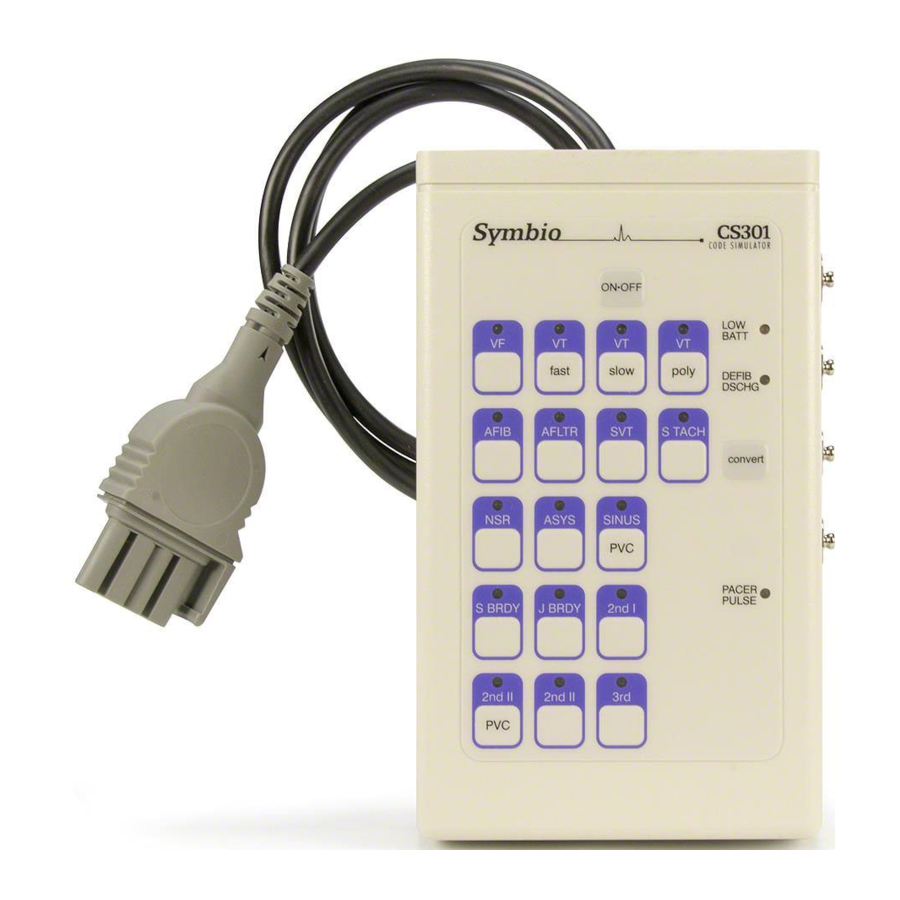
Symbio CS301 - Code Simulator Operating Manual
- Operating instructions (2 pages) ,
- Operating instructions (3 pages)
Advertisement

Controls and Indicators
The CS301Code Simulator is an easy to use training tool that allows you to practice defibrillation procedures, external pacing procedures, and arrhythmia recognition. Connect your defibrillator and external pacer directly to the CS301 for safe, interactive training. For arrhythmia recognition, select from 17 rhythms, including fibrillations, tachycardias, and bradycardias.

LOW BATT
Red indicator illuminates when battery needs to be replaced.
DEFIB DISCHG
Green indicator illuminates for two seconds when defib discharge is sensed.
convert
Simulate cardioversion by activating convert feature. CS301 responds to defib discharge.
PACER PULSE
Green indicator flashes when external pacer pulse is sensed. (Captured beat is simulated, too.) Sensing occurs when external pacer current set to 60mA - 70mA or more.
convert
The convert feature allows you to convert automatically from one rhythm (running rhythm) to another rhythm (waiting rhythm) when a discharge is delivered from a defibrillator set to 50J or more.
To perform convert operation:
- Press convert key. Indicator of running rhythm pulses brighter.
- Press key of rhythm to be simulated immediately after defib discharge. Indicator of this (waiting) rhythm blinks on and off.
- Discharge defibrillator. The waiting rhythm becomes the running rhythm. To cancel convert operation before it's completed, either press convert key again or press key of running rhythm. If convert operation is started, but a discharge is not sensed within two minutes, the convert operation cancels automatically.
Rhythms for Defibrillator Training
VF Ventricular Fibrillation.
VT fast Ventricular Tachycardia. Wide QRS. Rate: 185.
VT slow Ventricular Tachycardia. Wide QRS. Rate: 140.
VT poly Ventricular Tachycardia. Fluctuating QRS axis.
AFIB Atrial Fibrillation. Ventricular rate: 120 to 160.
AFLTR Atrial Flutter (2:1). Ventricular rate: 150.
SVT SVT alternates with NSR, then remains in SVT. SVT rate: 216.
S TACH Sinus Tachycardia. Rate: 120.
NSR Normal Sinus Rhythm. Rate: 72.
ASYS Asystole.
SINUS PVC Sinus Rhythm with PVCs. Sinus rate: 72.
Rhythms for External Pacer Training
S BRDY Sinus Bradycardia. Rate: 40.
J BRDY Junctional Bradycardia. Rate: 42.
2nd I 2nd deg. type I AV Block (4:3). Atrial rate: 60.
2nd II PVC 2nd deg. type II AV Block (4:3). PVCs. Wide QRS. Atrial rate: 60.
2nd II 2nd deg. type II AV Block (4:3). Wide QRS. Atrial rate: 60.
3rd 3rd deg. AV Block. Wide QRS. Ventricular rate: 37.
Defibrillator Exercise
Connect simulator to defibrillator. For help, see Getting Started..
Exercise: Convert VF to NSR using manual defibrillator.
at simulator:
- Press VF key. VF indicator glows steadily. Confirm VF is displayed on monitor.
- Press convert key. VF indicator pulses brighter.
- Press NSR key. NSR indicator blinks on and off. VF indicator glows steadily again.
at defibrillator:
- Select 360J using Energy Select switch (1).
- Press Charge button (2). Listen for charge ready tone.
- Press both Discharge buttons (3) simultaneously.
- After discharge observe that:
On monitor, NSR is displayed.
At simulator, NSR indicator glows steadily, and VF indicator is off.
Deliver defibrillation discharge to convert automatically.

External Pacer Exercise
Connect simulator to external pacer. For help, see Getting Started.
To simulate paced beats, pacer Rate must be greater than rate of selected rhythm, and pacer Current must be greater than simulator capture level.
Exercise: Pace 3rd degree AV block at rate of 70 ppm.
at simulator:
- Press 3rd key. Confirm 3rd degree AV block is displayed on monitor.
at pacer:
- Select Pacer On. Verify sense markers are displayed with each R wave. (If not, press ECG Size button until R wave markers are observed.)
- Select rate of 70 ppm usingRate control.
- Press Start/Stop button to start pacing.
- Increase pacer current, using Output control, until you observe paced beats on monitor. Pacer current setting should read 60mA - 70mA.
Initiate pacing to simulate paced beats.

Note: If VF is selected rhythm, simulator won't generate paced beats.
Battery Saver Feature
The simulator powers-off automatically about 30 minutes after a key was last pressed, or after defib or pacer energy was last detected. This is normal operation.
To allow simulator to remain powered-on after 30 minutes, follow these instructions:
- Power-off simulator.
- Press and hold down convert key, then press and release ON OFF key. The simulator powers-on.
- Observe NSR indicator. When indicator blinks on and off, release convert key. NSR indicator continues to blink for about one second.
The battery saver feature is now disabled. When you power-off the simulator, it will return to normal battery saver operation.
The simulator is powered by one 9 volt alkaline battery. To replace the battery, turn over simulator, then slide open battery compartment door.
Service
The CS301 Code Simulator is warranted to be free of defects in material or workmanship for three years from date of purchase.
If the simulator needs service, or if you have questions about its operation, please contact Symbio customer service, or your authorized dealer.
Symbio Corporation
1600 NW Compton Drive
Suite 120
Beaverton, Oregon
U.S.A. 97006
voice: 503.748.2030
fax: 503.748.2031
Getting Started
- Connect monitor's ECG cable to simulator's ECG snaps. See Figure 1.
- Connect defibrillation cable to simulator's defib cable receptacle. See Figure 2.
- Press ON OFF key to power-on simulator. Observe that NSR indicator is illuminated.
- Power-on monitor/defibrillator. Observe that NSR at 72 bpm is displayed.
Press ECG cable connectors onto simulator snaps.
Left to right: RL, RA, LA, LL.
ECG signal is obtained with either 3- or 4-lead ECG cable.

Connect defibrillation cable to simulator. (The connector on your simulator may be different from the one shown here.)

SHOCK HAZARD!
Be sure defibrillation cable is securely attached to simulator.

Documents / Resources
References
Download manual
Here you can download full pdf version of manual, it may contain additional safety instructions, warranty information, FCC rules, etc.
Advertisement




Need help?
Do you have a question about the CS301 and is the answer not in the manual?
Questions and answers